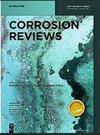On the role of surface stress in environment-assisted fracture
IF 2.7
4区 材料科学
Q3 ELECTROCHEMISTRY
引用次数: 0
Abstract
Environment effects in plasticity and fracture of metals, well studied for several decades, still pose many unanswered questions. A micro-mechanics explanation of how dislocation activity is influenced by the material surface state, that can answer these questions, has been elusive. We build on a recently discovered effect in metal cutting – organic monolayer embrittlement (OME) – wherein metal surfaces are rendered brittle by long-chain organic adsorbates, to explore how material state variables influence surface plasticity and fracture. In particular, cutting experiments with Al containing Self Assembled Monolayers (SAMs), show that the OME is controlled by surface stress (f) induced by the adsorbates. This is contrary to many instances of environment-assisted fracture which are usually attributed to surface energy changes, and wherein f is largely ignored. Other contributions include (a) a cantilever technique to measure surface stress, (b) demonstration of strong effect of SAM molecule chain length on f, (c) characterization of how dislocation activity at crack-tips is affected by adsorbate-induced f, and (d) large improvements in machining processes enabled by controlled environment-assisted fracture. We make the case that surface stress, due to adsorbates, likely influences all environmentally assisted cracking (EAC) phenomena, warranting a revisit of extant models of EAC.表面应力在环境辅助断裂中的作用
环境对金属塑性和断裂的影响已被研究了几十年,但仍有许多问题没有答案。关于位错活动如何受材料表面状态影响的微观力学解释一直未能解答这些问题。我们以最近发现的金属切削效应--有机单层脆化(OME)--即金属表面受长链有机吸附剂影响而变脆为基础,探索材料状态变量如何影响表面塑性和断裂。特别是对含有自组装单分子层(SAM)的铝进行的切割实验表明,OME 受吸附剂引起的表面应力(f)控制。这与环境辅助断裂的许多实例相反,后者通常归因于表面能量变化,而 f 在很大程度上被忽视。其他贡献包括:(a)测量表面应力的悬臂技术;(b)证明 SAM 分子链长度对 f 的强烈影响;(c)描述裂纹尖端的位错活动如何受到吸附剂引起的 f 的影响;以及(d)受控环境辅助断裂对加工工艺的重大改进。我们认为,吸附剂导致的表面应力可能会影响所有环境辅助开裂(EAC)现象,因此有必要重新审视现有的 EAC 模型。
本文章由计算机程序翻译,如有差异,请以英文原文为准。
求助全文
约1分钟内获得全文
求助全文
来源期刊

Corrosion Reviews
工程技术-材料科学:膜
CiteScore
5.20
自引率
3.10%
发文量
44
审稿时长
4.5 months
期刊介绍:
Corrosion Reviews is an international bimonthly journal devoted to critical reviews and, to a lesser extent, outstanding original articles that are key to advancing the understanding and application of corrosion science and engineering in the service of society. Papers may be of a theoretical, experimental or practical nature, provided that they make a significant contribution to knowledge in the field.
文献相关原料
| 公司名称 | 产品信息 | 采购帮参考价格 |
|---|
 求助内容:
求助内容: 应助结果提醒方式:
应助结果提醒方式:


